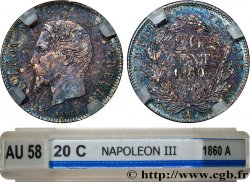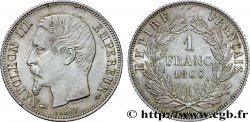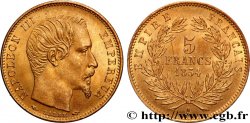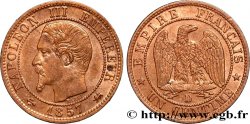fme_412632 - SECOND EMPIRE Médaille de mariage de Napoléon III et Eugénie
无库存.
所有在网站上销售的产品 (2017)
价格 : 200.00 €
所有在网站上销售的产品 (2017)
价格 : 200.00 €
种类 Médaille de mariage de Napoléon III et Eugénie
日期: 1853
铸币厂名称/城市 75 - Paris
材质 tin
直径 53 mm
模子方针 12 h.
硬币制模工 MONTAGNYJean-Pierre (1789-1862)
重量 42 g.
侧面 lisse
关于品相的说明
Magnifique médaille en état neuf, avec encore le brillant d’origine
正面
正面的文字 EUGÉNIE - IMPÉRATRICE / 1853.
正面的说明书 Tête à droite d’Eugénie.
背面
背面的文字 NAPOLÉON II EMPEREUR DES FRANÇAIS EUGÉNIE IMPÉRATRICE MARIÉS LE 30 JANVIER 1853.
背面的说明书 Couronne impériale sur fond d’abeilles, dans une couronne orné de 5 étoiles et de 5 aigles impériaux.
评论
Médaille signée MONTAGNY 1853 F. pour MONTAGNYJean-Pierre (1789-1862).
María Eugenia Ignacia Agustina de Palafox-Portocarrero de Guzmán y Kirkpatrick, marquise d’Ardales, marquise de Moya, comtesse de Teba, comtesse de Montijo — dite Eugénie de Montijo —, née le 5 mai 1826 à Grenade et décédée le 11 juillet 1920 au palais de Liria à Madrid, est une personnalité politique française d’origine espagnole.
Épouse de Napoléon III, empereur des Français, et donc impératrice des Français du 29 janvier 1853 au 4 septembre 1870, elle était considérée comme une des plus belles femmes de son époque.
En 1849, elle fait la connaissance de Louis-Napoléon Bonaparte, président de la République française dans l'hôtel de Mathilde Bonaparte, puis lors de réceptions à l'Élysée. Dès leur rencontre celui qui n'est alors que le « prince-président » est séduit. Le siège qu'il entreprend auprès d'Eugénie dure deux ans, sa cour assidue lors de séjours au château de Compiègne étant à l'origine de l'épisode du « trèfle de Compiègne ». Les familiers de l'empereur sont au début assez partagés envers la comtesse espagnole, certains souhaitant que l'Empereur se lie avec une famille régnante, comme autrefois Napoléon avec Marie-Louise.
Cependant, les souverains européens, même ceux apparentés au nouvel empereur, sont fort peu enclins à donner une de leurs filles en mariage à un empereur au trône mal assuré et qu'ils regardent comme un parvenu voire un aventurier.
Le 12 janvier 1853, un incident lors d'un bal aux Tuileries, où la jeune Espagnole se fait traiter d'aventurière par Madame Hippolyte Fortoul, épouse du ministre de l’éducation, précipite la décision de Napoléon III de demander Eugénie en mariage alors qu'il vient de mettre un terme à sa relation avec Miss Howard..
María Eugenia Ignacia Agustina de Palafox-Portocarrero de Guzmán y Kirkpatrick, marquise d’Ardales, marquise de Moya, comtesse de Teba, comtesse de Montijo — dite Eugénie de Montijo —, née le 5 mai 1826 à Grenade et décédée le 11 juillet 1920 au palais de Liria à Madrid, est une personnalité politique française d’origine espagnole.
Épouse de Napoléon III, empereur des Français, et donc impératrice des Français du 29 janvier 1853 au 4 septembre 1870, elle était considérée comme une des plus belles femmes de son époque.
En 1849, elle fait la connaissance de Louis-Napoléon Bonaparte, président de la République française dans l'hôtel de Mathilde Bonaparte, puis lors de réceptions à l'Élysée. Dès leur rencontre celui qui n'est alors que le « prince-président » est séduit. Le siège qu'il entreprend auprès d'Eugénie dure deux ans, sa cour assidue lors de séjours au château de Compiègne étant à l'origine de l'épisode du « trèfle de Compiègne ». Les familiers de l'empereur sont au début assez partagés envers la comtesse espagnole, certains souhaitant que l'Empereur se lie avec une famille régnante, comme autrefois Napoléon avec Marie-Louise.
Cependant, les souverains européens, même ceux apparentés au nouvel empereur, sont fort peu enclins à donner une de leurs filles en mariage à un empereur au trône mal assuré et qu'ils regardent comme un parvenu voire un aventurier.
Le 12 janvier 1853, un incident lors d'un bal aux Tuileries, où la jeune Espagnole se fait traiter d'aventurière par Madame Hippolyte Fortoul, épouse du ministre de l’éducation, précipite la décision de Napoléon III de demander Eugénie en mariage alors qu'il vient de mettre un terme à sa relation avec Miss Howard..








 对产品描述纠错
对产品描述纠错 打印
打印 分享我的选择
分享我的选择 提问
提问 Consign / sell
Consign / sell
 产品介绍
产品介绍



